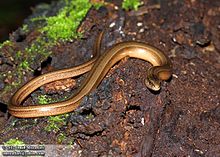Eastern slow worm
| Eastern slow worm | ||||||||||||
|---|---|---|---|---|---|---|---|---|---|---|---|---|

An eastern slow worm ( Anguis colchica ) |
||||||||||||
| Systematics | ||||||||||||
|
||||||||||||
| Scientific name | ||||||||||||
| Anguis colchica | ||||||||||||
| ( Nordmann , 1840) |
The eastern slowworm ( Anguis colchica ), also known as the colchian slowworm , is a species of reptile belonging to the creeping family and lives in eastern Europe and western Asia .
features
The total length is up to 59 cm, the head-torso length up to 29 cm. Females grow slightly larger than males. Young animals have a total length of 6 to 12 cm. The body is legless and elongated, an outer ear opening is almost always visible. In the middle of the body there are 26–30 longitudinal rows of scales. Females have a light, lead-colored top that is set apart from the darker flanks and usually a dark back line. The males have a thicker head than the females. They are greyish, light brown or reddish-brown on top and not as rich in contrast as the females or young animals. They often lack the center line, but they often have small blue spots on the upper side, which are much rarer in females. Young animals are very light on the upper side, almost whitish to pale yellowish, golden or silver-gray and they have a teardrop-shaped, dark brown markings on their heads, as well as a narrow, black-brown topline.
distribution
The distribution area of the eastern slow worm borders in the west to the distribution area of the slow worm ( Anguis fragilis ). It extends from eastern Poland , Slovakia , Hungary and Serbia to the east via Bulgaria , Romania , Ukraine , the Republic of Moldova and Belarus to Russia . In the north, the Baltic states of Estonia , Latvia and Lithuania , as well as the south of Finland, are settled. In the south-east there is a second, separate distribution area, which extends from the European part of Turkey over the northern coastal areas of Turkey to the Caucasus and the southern coast of the Caspian Sea . The Black Sea coast is almost completely settled.
habitat
From sea level to 2300 m above sea level in the Caucasus. In Romania, the species is rare in the lowlands, but it is common in the hilly and mountainous areas (100–1200 m above sea level), especially in warm valleys. Like the western slow worm, this species populates a wide range of habitats, such as light forests - especially deciduous forests - with old stumps and dead wood, aisles, clearings, herbaceous paths, variously structured forest edges, bushy slopes with rocky areas, quarries, railway embankments, grassy ditch slopes, Gardens and others. Close to the ground, the species prefers vegetation rich in cover and a certain amount of moisture.
Way of life
Depending on the area and regional climate, active from March to November, in northern Russia only from June. The way of life is similar to that of the western slow worm . The mating takes place in Bulgaria from the middle of April to the beginning of June, the weaning of the 3–26 cubs takes place here from the end of June to the end of July. In general, however, depending on the weather, the young can be weaned significantly later. For Romania June – September is given, for Slovakia November 11th is given as the extreme. Sexual maturity is reached in males at 3–4 years, in females at 4–5 years. The animals can be 10–15 years old, in exceptional cases also considerably older.
Taxonomy
Until 1990, all species of the slow worms ( Anguis ) were united in one group under the name Anguis fragilis , as it was very difficult or impossible to differentiate them morphologically . It was not until 2010 that the eastern slow worm could be separated out as a clearly delineated species using molecular biological methods together with the Greek slow worm. The Italian slow worm ( Anguis veronensis ) followed in 2013 .
Individual evidence
- ↑ Dieter Glandt: The amphibians and reptiles of Europe: All kinds in portrait. 2nd, updated and expanded edition. Quelle & Meyer, Wiebelsheim 2015, ISBN 978-3-494-01581-1 , pp. 320–322.
- ↑ V. Gvoždík, N. Benkovský, A. Crottini, A. Bellati, J. Moravec, A. Romano, R. Sacchi, D. Jandzík: An ancient lineage of slow worms, genus Anguis (Squamata: Anguidae), survived in the Italian Peninsula. In: Molecular Phylogenetics and Evolution. Volume 69, No. 3, 2013, pp. 1077-1092, doi: 10.1016 / j.ympev.2013.05.004 .
literature
- Dieter Glandt: The amphibians and reptiles of Europe: All kinds in portrait. 2nd, updated and expanded edition. Quelle & Meyer, Wiebelsheim 2015, ISBN 978-3-494-01581-1 , pp. 320–322.
Web links
- Anguis colchica in The Reptile Database . Edited by: P. Uetz, P. Freed, J. Hošek, 1995–2020. Retrieved August 15, 2020.
